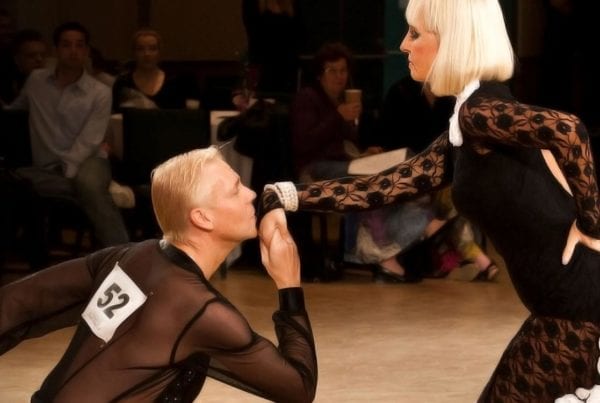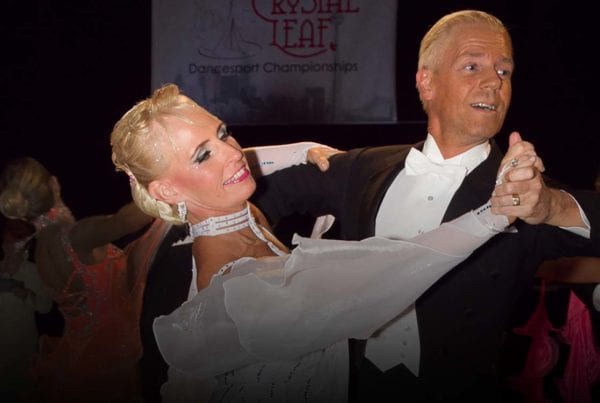The Outside Change. A basic figure in the Waltz. Three simple steps (technically four but that last step is actually part of the next figure). Yet as simple as it is, within those movements exists a world of technique that can make the figure look spectacular.
Sadly, I once heard a bronze-level competitor complain about the Outside Change in their routine, claiming that it was a boring figure and hoping that the teacher would consider removing it from the routine. That’s sad because it has such potential to make your dancing stand out from the crowd when danced with understanding.
The Outside Change consists of three steps. In the technique book, a fourth step is included in the Outside Change, but essentially that’s the start of a new figure so I’ll ignore that step for the purpose of this article. The figure is a “change” step partly because it changes feet (you only have two feet so any odd-numbered group of steps will change feet), and also because it changes direction. It’s an “outside” figure because it ends in such a way that the fourth step is taken outside partner. It can also finish by opening to Promenade Position.
The figure can turn different amounts. Most of the time it turns one quarter to the left, but it can turn quite a bit more. The figure is used as the ending three steps of the Weave and the Weave from PP. It can begin either in Closed Position with the lady stepping in between the man’s feet, or from Outside Partner Position with the lady stepping outside the man on the first step. There is one musical beat count for each step, but as usual in the Waltz, we can cheat the timing to make the second step visually longer for added impact.
What I love about the Outside Change is the way that it emulates a common action that Fred Astaire applied in his dancing, where he would rotate while drawing his feet underneath him. This creates a lovely effect of making the body appear to hover in space over the legs before moving on in another direction.
Basic Technique
The basic figure begins with the man stepping back with his left foot, backing diagonal to center. The lady steps forward with her right foot between the man’s feet, or outside depending on the previous figure.
The man uses his toe but the heel lowers as his body arrives over the left foot. This technique is known as “no foot rise.” The lady uses her heel on step 1, switching to the toe as her body moves toward and over the right foot.
For the second step, the movement continues in the same direction. The man steps back with the toe of the right foot, continuing to rise. The lady steps forward with her left toe, also continuing to rise. There is some Cross Body Movement (CBM) on this step.
At the end of step 2, the lead creates the desired amount of rotation. You can only effectively rotate on your toes or on your heel. Note that the body turns a little less than the feet. After rotating, the man steps forward with the left foot. The lady steps back with her right foot (or forward if in Promenade Position). With the bodies slightly under turned in relation to the foot positions (CBM), the man can now step outside the lady with his right foot in CBMP on the fourth step (this step really belongs to the next figure).
There is no sway on any of the steps.
Improving The Styling
Where this figure goes wrong is usually because one or both partners are too quick to place their foot to the ending alignment. They kind of ronde the leg sideways to point in a new direction. By swinging the leg out to the side, the momentum of that movement and the weight of the leg pulls the partnership into the final position too early. Not only does this pull the partner off their foot, it also takes away from the beauty of this figure.
What makes the Outside Change shine is the act of drawing the non-supporting foot underneath your body before stepping out with it. This happens as the body moves toward the standing foot in between steps 2 and 3. Drawing in that foot has the effect of bringing the feet fairly close together, even in a slightly crossed position if there is a lot of rotation.
The third step is taken on the toe. Again, this is where many dancers ruin the appearance of this beautiful figure, by dropping onto a flat foot too early. Keep the heel up until the moving foot collects to move past the standing foot. By lowering the heel gradually your movement becomes smooth and elegant rather than looking clunky.
Open Finish
An alternative ending is the open finish, with the partners in Promenade Position. In that case, the lady will step forward with her right foot rather than stepping back. Too often, when the man wishes to finish in PP, he swings his leg out to the side on step 3. You should always focus on drawing the moving leg underneath you, and only then leading the Promenade opening.
This lead to the open ending is done by swiveling the feet and a slight rotation of the man’s center. Think of it as if you are holding the lid of a jar and turning the base of the jar to the left.
When opening to Promenade, in most cases the lady’s feet are already in the position they need to be to step forward, so the lady should not open any further. Instead, she just turns her head to the right and steps forward. Just as in the closed finish, the third step is taken onto the toe and the heel only lowers as the back foot passes through to take the next step.
My hope for social dancers is that they use this information to make the Outside Change the beautiful figure it deserves to be.
Below is a video tutorial covering some of the things discussed in this post.













